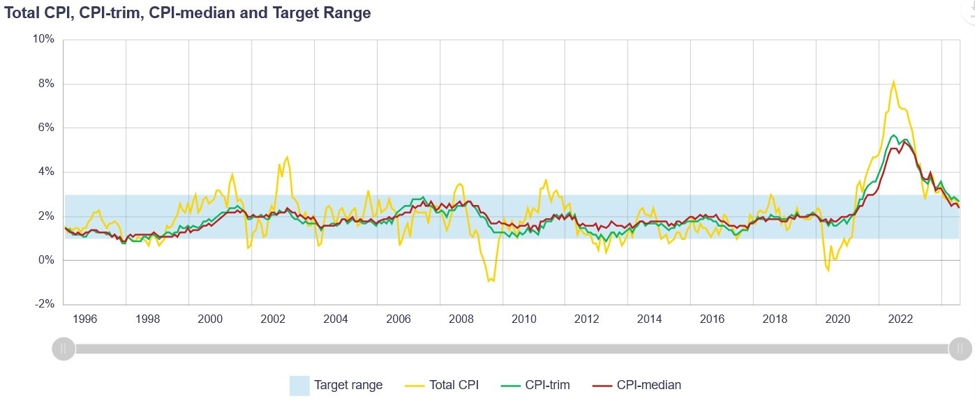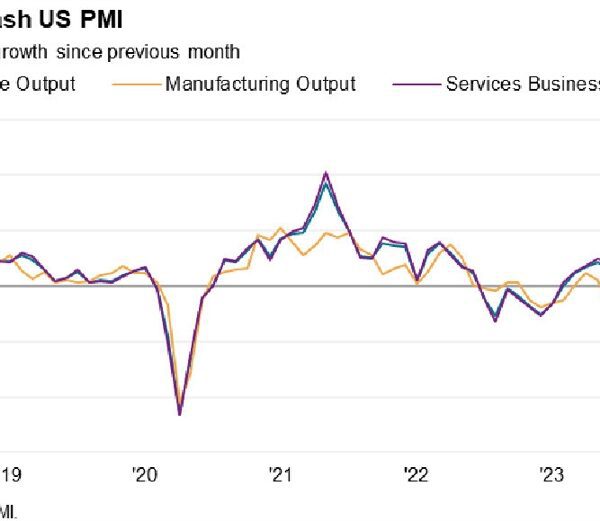UPCOMING
EVENTS:
- Monday: New Zealand Services PMI.
- Tuesday: Eurozone ZEW, Canada CPI, US Retail Sales, US
Industrial Production and Capacity Utilization, US NAHB Housing Market
Index. - Wednesday: UK CPI, US Housing Starts and Building Permits,
BoC Summary of Deliberations, FOMC Policy Decision. - Thursday: New Zealand Q2 GDP, Australia Labour Market
report, BoE Policy Decision, US Jobless Claims. - Friday: Japan CPI, PBoC LPR, BoJ Policy Decision, UK
Retail Sales, Canada Retail Sales.
Tuesday
The Canadian CPI
Y/Y is expected at 2.1% vs. 2.5% prior, while the M/M measure is seen at 0.0%
vs. 0.4% prior. As always, focus will be on the underlying inflation measures.
The Trimmed Mean CPI Y/Y is expected at 2.5% vs. 2.7% prior and the Median CPI
Y/Y is seen at 2.3% vs. 2.4% prior.
The BoC is
expected to cut rates by 25 bps at both the last two meetings left for this
year, but there’s also a chance that the central bank delivers bigger rate cuts
if growth and inflation were weaker than projected as Governor Macklem mentioned last week.
Canada Inflation Measures
The US Retail
Sales M/M is expected at 0.2% vs. 1.0% prior, while the Ex-Autos M/M measure is
seen at 0.3% vs. 0.4% prior. The focus will be on the Control Group figure
which is expected at 0.2% vs. 0.3% prior.
Consumer spending
has been stable which is something you would expect given the positive real
wage growth and resilient labour market. We’ve also been seeing a steady pickup
in the UMich Consumer
Sentiment which suggests
that consumers’ financial situation is stable/improving.
US Retail Sales YoY
Wednesday
The UK CPI Y/Y is
expected at 2.2% vs. 2.2% prior, while the M/M measure is seen at 0.3% vs.
-0.2% prior. The Core CPI Y/Y is expected at 3.5% vs. 3.3% prior, while the M/M
figure is seen at 0.4% vs. 0.1% prior.
The market expects
the BoE to keep rates unchanged at the upcoming meeting and then cut rates by
25 bps in November and December.
UK Core CPI YoY
The consensus
among economists sees the Fed cutting rates by 25 bps. The market pricing
though is evenly split between a 25 and 50 bps cut. Some people say that
starting with a standard 25 bps would be better because the economy is still
fine, and 50 bps might be seen as panicky.
Central banking is
also about risk management though. The market pricing is giving the Fed a nice
opportunity to deliver a 50 bps “insurance cut” without surprising. Things
would have been much different if we had something like 30% probabilities for a
50 bps cut and 70% for a 25 bps one.
The Fed didn’t
have the chance to see the labour market report last July as the data was
released two days later. Maybe, if they had the data a week earlier, we might
have seen them cutting by 25 bps back then already and then continuing with 25
bps cuts for the subsequent meetings.
Fed Chair Powell
made it clear at the Jackson Hole Symposium that they will not tolerate more
labour market weakening and they will do everything they can to keep it strong.
Considering everything, starting with a 50 bps cut makes much more sense.
The Fed can then
show that it was just an insurance cut via its Summary of Economic Projections
and Powell can double down on that at the Press Conference. Speaking of the
SEP, the market is expecting the Fed to deliver at least 100 bps of easing by
year-end. The Fed can cut by 50 bps and then project two more 25 bps cuts by
year-end.
Further out, the
market expects the Fed to deliver 150 bps of easing in 2025 which seems too
aggressive at the moment. To sum up, I personally expect the Fed to cut rates
by 50 bps, but in the end what’s important is that the Fed is finally starting
to ease its policy and the magnitude will be shaped by the data in the next
months.
Federal Reserve
Thursday
The Australian
Labour Market report is expected to show 30.0K jobs added in August vs. 58.2K
in July and the Unemployment Rate to remain unchanged at 4.2%. The market
expects the RBA to deliver the first rate cut in February 2025, but the
probabilities can be brought forward to December 2024 if the data
were to disappoint in the next months.
Australia Unemployment Rate
The BoE is
expected to keep rates unchanged at 5.00%. The expectations for such a move
have been shaped by relatively strong data with PMIs firmly in expansion,
inflation moderating at a slow pace and the unemployment rate ticking lower.
The market then expects the central bank to cut by 25 bps in November and
December.
Bank of England
The US Jobless
Claims continues to be one of the most important releases to follow every week
as it’s a timelier indicator on the state of the labour market.
Initial Claims
remain inside the 200K-260K range created since 2022, while Continuing Claims
have been on a sustained rise (although they’ve improved recently) showing that
layoffs are not accelerating and remain at low levels while hiring is more
subdued.
This week Initial
Claims are expected at 230K vs. 230K prior, while there’s no consensus for Continuing
Claims at the time of writing although the prior release showed an increase to
1850K.
US Jobless Claims
Friday
The Japanese Core
CPI Y/Y is expected at 2.8% vs. 2.7% prior. Inflation has been picking up
alongside wage growth which are two of the most important factors for the BoJ. Nonetheless,
the BoJ is expected to keep rates unchanged this time around and potentially
deliver another rate hike by the end of the year.
Japan Core CPI YoY
The BoJ is
expected to keep interest rates unchanged at 0.25%. The focus will be on the
Press Conference as the markets will be attentive to signals or hints on the
timing of the next rate hike.
Several BoJ
officials kept the rate hikes on the table as they want to normalise policy to
a more neutral stance. Markets instability has been a major concern for the central
bank, so they will likely wait for the Fed to be a bit more down the road in
its easing cycle before tightening policy further.
Bank of Japan
The PBoC is
expected to keep the 1 year and 5 year LPR rates unchanged at 3.35% and 3.85%
respectively. The Chinese economic data hasn’t been exactly good and
deflationary risks remain high. Chinese officials should really go harder on
monetary policy easing and bring real rates down from the current high levels.
People’s Bank of China















